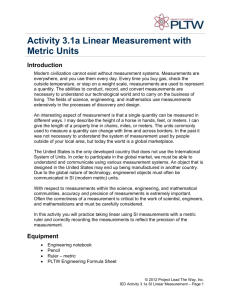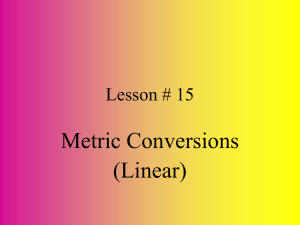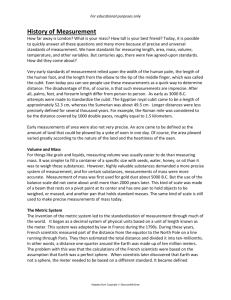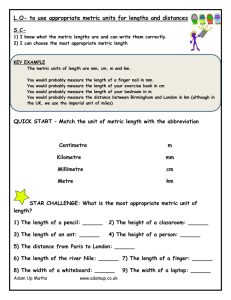Activity 1.3.1 English and Metric Measuring
advertisement
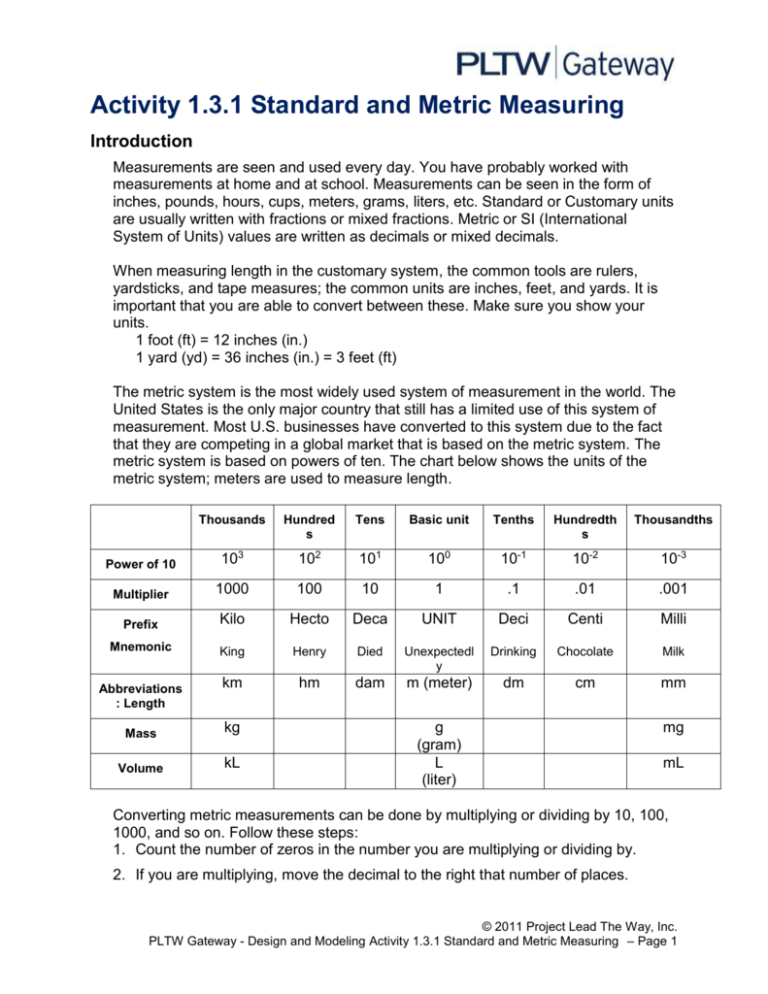
Activity 1.3.1 Standard and Metric Measuring Introduction Measurements are seen and used every day. You have probably worked with measurements at home and at school. Measurements can be seen in the form of inches, pounds, hours, cups, meters, grams, liters, etc. Standard or Customary units are usually written with fractions or mixed fractions. Metric or SI (International System of Units) values are written as decimals or mixed decimals. When measuring length in the customary system, the common tools are rulers, yardsticks, and tape measures; the common units are inches, feet, and yards. It is important that you are able to convert between these. Make sure you show your units. 1 foot (ft) = 12 inches (in.) 1 yard (yd) = 36 inches (in.) = 3 feet (ft) The metric system is the most widely used system of measurement in the world. The United States is the only major country that still has a limited use of this system of measurement. Most U.S. businesses have converted to this system due to the fact that they are competing in a global market that is based on the metric system. The metric system is based on powers of ten. The chart below shows the units of the metric system; meters are used to measure length. Thousands Hundred s Tens Basic unit Tenths Hundredth s Thousandths Power of 10 103 102 101 100 10-1 10-2 10-3 Multiplier 1000 100 10 1 .1 .01 .001 Prefix Kilo Hecto Deca UNIT Deci Centi Milli Mnemonic King Henry Died Unexpectedl y Drinking Chocolate Milk km hm dam m (meter) dm cm mm Abbreviations : Length Mass kg Volume kL g (gram) L (liter) mg mL Converting metric measurements can be done by multiplying or dividing by 10, 100, 1000, and so on. Follow these steps: 1. Count the number of zeros in the number you are multiplying or dividing by. 2. If you are multiplying, move the decimal to the right that number of places. © 2011 Project Lead The Way, Inc. PLTW Gateway - Design and Modeling Activity 1.3.1 Standard and Metric Measuring – Page 1 3. If you are dividing, move the decimal to the left that number of places. 4. Don’t forget to include units. Occasionally you may need to convert from English to Metric units or vice versa. The conversion chart for this is below. Convert from: mile inch inch foot yard kilometer millimeter centimeter meter meter To: kilometer millimeter centimeter meter meter mile inch inch foot yard Multiply by: 1.609347 km/mi 25.4 mm/in. 2.54 cm/in. .3048 m/ft .9144 m/yd .6214 mi/km .0394 in./mm .3937 in./cm 3.281 ft/m 1.094 yd/m Equipment PLTW Gateway notebook Measuring devices (ruler, metric ruler, yard stick, meter stick, tape measure) Procedure In this activity you will have a chance to practice your Metric and English measuring skills. 1. Complete the English and Metric measurement questions in this activity. 2. Complete the “Educated Guess” columns of the chart. 3. Obtain several measuring devices from your instructor and complete the actual measurement section of the chart. 4. Complete the conclusion questions and turn in to your instructor for grading. 1. Does the ruler on the left measure in Metric or English units? 2. What units would you use? 3. What is the distance from the end of the ruler to each point? Don’t forget to include units. A. © 2011 Project Lead The Way, Inc. PLTW Gateway - Design and Modeling Activity 1.3.1 Standard and Metric Measuring – Page 2 B. C. D. E. 4. What is the equivalent of measurement C in inches? Show all work, round answer to nearest tenth. 5. Does the ruler on the left measure in Metric or English units? 6. What units would you use? 7. What is the distance from the end of the ruler to each point? Don’t forget to include units. A. B. C. D. E. 8. What is the equivalent of measurement C in millimeters? Show all work, round answer to nearest tenth. © 2011 Project Lead The Way, Inc. PLTW Gateway - Design and Modeling Activity 1.3.1 Standard and Metric Measuring – Page 3 9. Complete the chart below by entering an educated guess of the length of each object in the units provided. Then obtain the proper measuring tool: ruler, metric ruler, yard stick, meter stick, or tape measure. Record the correct measurement in the chart. Don’t forget to include units. Item Educated Guess English Notebook Educated Guess - Metric in. cm Desk ft m Door yd m Pencil in. mm Cabinet ft m Window in. cm Bulletin Board yd m Actual English Measurement Actual Metric Measurement Conclusion 1. Which measurement system is easier for you to use? Why? 2. Convert the length of a 2 ft 6 in. desk to each of the following. Show your equations and math. a. _________________ inches (in.) b. _________________ yards (yd) c. _________________ meters (m) d. _________________ centimeters (cm) 3. Convert the length of a 4.5 meter bulletin board to each of the following. Show your equations and math. a. _________________ centimeters (cm) © 2011 Project Lead The Way, Inc. PLTW Gateway - Design and Modeling Activity 1.3.1 Standard and Metric Measuring – Page 4 b. _________________ decameters (dam) c. _________________ feet (ft) d. _________________ yards (yd) 4. List four ways that you have used measurement in your life and identify the units that you used. For example, I drove 7 miles to get to school today – English units. © 2011 Project Lead The Way, Inc. PLTW Gateway - Design and Modeling Activity 1.3.1 Standard and Metric Measuring – Page 5




